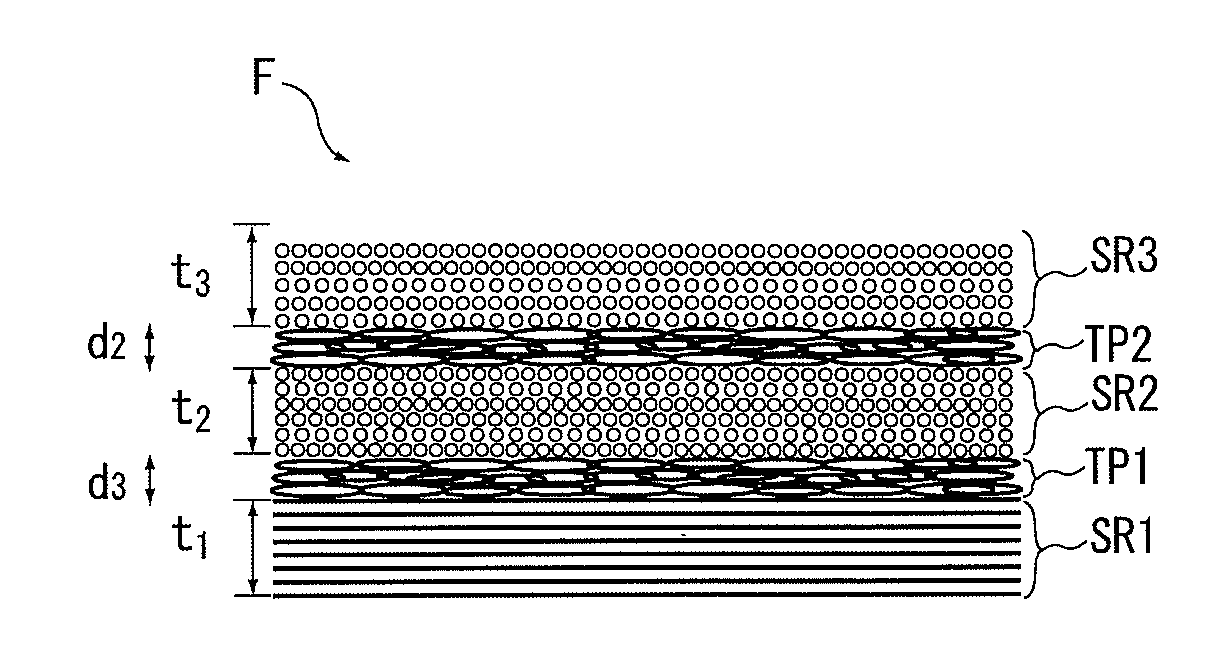Multiaxially reinforced laminated moldings and process for production thereof
a technology of laminated molding and multi-axial reinforcement, which is applied in the direction of layered products, transportation and packaging, chemistry apparatus and processes, etc., can solve the problems of low toughness of thermosetting resin materials, poor shock resistance of moldings, and layer separation, so as to prevent delamination (layer separation) and reduce the thickness of resin layers. , the effect of suppressing the stress concentration of that portion
- Summary
- Abstract
- Description
- Claims
- Application Information
AI Technical Summary
Benefits of technology
Problems solved by technology
Method used
Image
Examples
example 1
[0077]A multiaxially reinforced prepreg sheet was produced using the following materials.
(Fiber Used as Reinforcing Fiber)
[0078]T800SC-24K produced by Toray Industries, Inc., fiber diameter: about 5.5 μm, number of fibers: 24000
(Resin Material Used as Thermosetting Resin Material)
[0079]BT250E-1 produced by Bryte Technologies, Inc., epoxy resin
(Resin Material Used as Thermoplastic Resin Material)
[0080]SP-500 produced by Toray Industries, Inc., nylon 12 powder, average particle diameter: 5 μm
[0081](1) A reinforcing fiber tow T800SC-24K was spread to a width of 24 mm through a pneumatic tow-spreading method (refer to Japanese Patent No. 3049225) and wound around a reel as a multi-filament spread thread.[0082](2) Thirteen of the reels spooled with the multi-filament spread thread were arranged in the width direction to form a reinforcing fiber sheet having no gaps using the method and apparatus disclosed in Japanese Unexamined Patent Application Publication No. 2005-029912. The obtained...
example 2
[0089]A multiaxially reinforced prepreg sheet was produced using the following materials.
(Fiber Used as Reinforcing Fiber)
[0090]T800SC-24K produced by Toray Industries, Inc., fiber diameter: about 5.5 μm, number of fibers: 24000
(Resin Material Used as Thermosetting Resin Material)
[0091]BT250E-1 produced by Bryte Technologies, Inc., epoxy resin
(Resin Material Used as Thermoplastic Resin Material)
[0092]SP-500 produced by Toray Industries, Inc., nylon 12 powder, average particle diameter: 5 μm
[0093](1) A reinforcing fiber tow T800SC-24K was spread to a width of 24 mm through a pneumatic tow-spreading method (refer to Japanese Patent No. 3049225) and wound around a reel as a multi-filament spread thread.[0094](2) Thirteen of the reels spooled with the multi-filament spread thread were arranged in the width direction to form a reinforcing fiber sheet having no gaps using the method and apparatus disclosed in Japanese Unexamined Patent Application Publication No. 2005-029912. The obtained...
example 3
[0101]A multiaxially reinforced prepreg sheet was produced using the following materials.
(Fiber Used as Reinforcing Fiber)
[0102]HTA-12K produced by TOHO TENAX Co., Ltd., diameter: about 7 μm, number of fibers: 12000
(Resin Material Used as Thermosetting Resin Material)
[0103]BT250E-1 produced by Bryte Technologies, Inc., epoxy resin
(Resin Material Used as Thermoplastic Resin Material)
[0104]Hot-melt copolyamide resin powder CM842P48 produced by Toray Industries, Inc., average particle diameter: 80 μm, low melting point (115° C.) resin
[0105](1) A reinforcing fiber tow TA-12K was spread to a width of 20 mm through a pneumatic tow-spreading method (refer to Japanese Patent No. 3049225) and wound around a reel as a multi-filament spread thread.[0106](2) Sixteen of the reels spooled with the multi-filament spread thread were arranged in the width direction to form a reinforcing fiber sheet having no gaps using the method and apparatus disclosed in Japanese Unexamined Patent Application Publ...
PUM
| Property | Measurement | Unit |
|---|---|---|
| thickness | aaaaa | aaaaa |
| diameter | aaaaa | aaaaa |
| particle diameter | aaaaa | aaaaa |
Abstract
Description
Claims
Application Information
 Login to View More
Login to View More - R&D
- Intellectual Property
- Life Sciences
- Materials
- Tech Scout
- Unparalleled Data Quality
- Higher Quality Content
- 60% Fewer Hallucinations
Browse by: Latest US Patents, China's latest patents, Technical Efficacy Thesaurus, Application Domain, Technology Topic, Popular Technical Reports.
© 2025 PatSnap. All rights reserved.Legal|Privacy policy|Modern Slavery Act Transparency Statement|Sitemap|About US| Contact US: help@patsnap.com



